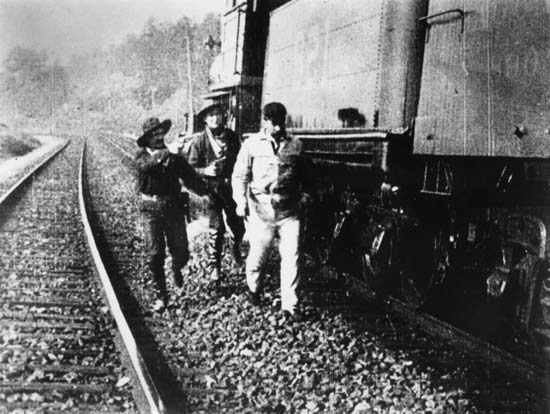
The first story films were very short — either little gags that could last less than a minute or narratives lasting about ten minutes. There's a reason for that. Because movies were a new form, novelties, they fell into story frames that audiences were already familiar with — newspaper cartoons and comic strips, which could be read in less than a minute, and vaudeville skits, which lasted about ten minutes. These familiar forms helped audiences fit story films into their habitual patterns of consuming entertainment.
In this era, movies and comic strips fed off each other, expanded each other's boundaries.
The first truly sensational American story film, The Great Train Robbery (see the frame grab above), appeared in 1903. There had been story films before this, or anecdotal films with narrative qualities, but The Great Train Robbery was so popular that it almost singlehandedly created the new market for story films. In a short time they had replaced gag films and actualities as the preferred cinematic form.
D. W. Griffith made his first ten-minute short in 1908 and at once began expanding the expressive range of the short story film. In 1909, the first regular comic strip, Mutt & Jeff (above) began appearing in newspapers. There had been multi-panel strips before this, along with single-panel cartoons that told little stories, but Mutt & Jeff signaled the emerging dominance of the strip. Just as single-panel cartoon gags had provided a template for early gag films, so the longer story films helped pave the way for the popularity of the multi-panel strip.
In the YouTube era of Internet cinema, we are about where projected movies were before The Great Train Robbery. The next step will probably be very similar to the next step projected movies took — into the territory of the newspaper cartoon and comic strip and vaudeville skit, all of which can be studied profitably as exercises in micro-fiction. The idea that Internet cinema can leap from the cute pet or baby video into feature-length narratives is a fantasy. People will eventually consume feature-length narratives via the Internet, but what happens between now and then will be intensely exciting. This is when the shape of cinema to come will be determined.
